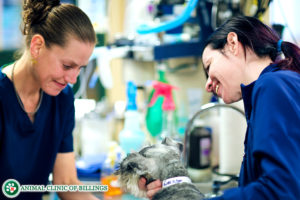Biceps Tendon Injury and Rupture
What is biceps tendinopathy/tenosynovitis?
The biceps tendon originates on the supraglenoid tubercle of the scapula (just in front of and above the joint surface of the shoulder blade), crosses the front of the shoulder joint, and merges with the biceps muscle, which extends down the front of the upper arm to attach to the bones of the forearm just in front of the elbow joint. The biceps functions to flex the elbow and stabilize the shoulder during weight bearing.
Biceps tendinopathy, also known as biceps tenosynovitis, is a condition in which the biceps tendon becomes damaged, causing pain and lameness. This damage is characterized by variable degrees of inflammation, fibrosis (scarring), and dystrophic mineralization (mineral deposits within the tendon).
What causes biceps tendinopathy/tenosynovitis?
While the definitive cause of biceps tendinopathy/tenosynovitis is not known, it tends to be associate with long-term strain on the shoulder from heavy loading and/or a high level of activity. The area where the tendon attaches to the scapula has been shown to have a relatively limited blood supply, which may play a role in the perpetuation of this condition by impairing the body’s normal healing processes.
What are the clinical signs of biceps tendinopathy/tenosynovitis?
Animals affected by biceps tendon disease tend to exhibit chronic waxing and waning lameness in the affected limb. This lameness usually improves with rest and worsens with exercise. In most cases, only one shoulder is affected, but sometimes both shoulders can be involved.
Biceps tendinopathy/tenosynovitis occurs most commonly in medium and large breed dogs, but can develop in dogs of any size. It may be seen in adult dogs of any age.
How is biceps tendinopathy/tenosynovitis diagnosed?
The diagnosis of biceps tendon disease begins with an orthopedic examination. Affected dogs are typically painful on palpation of the biceps tendon and on flexion of the shoulder with simultaneous extension of the elbow. They may also exhibit a decrease in muscle mass around the shoulder.
Precisely positioned x-rays of the shoulder are acquired under sedation or anesthesia. While not all dogs with biceps tendon disease will show abnormalities on x-rays, changes such as roughening of the bone where the biceps tendon attaches and mineralization within and around the biceps tendon are strong indicators of biceps tendon disease.
In cases where a diagnosis cannot be made on the basis of a physical examination and x-rays, musculoskeletal ultrasound or an MRI may be uses to identify abnormalities within the structure of the tendon. Definitive confirmation of the diagnosis can be made using arthroscopy.
How is biceps tendinopathy/tenosynovitis treated?
Mild cases that have only been going on for a short period of time may respond to conservative management consisting of 4 to 8 weeks of anti-inflammatory medication, strict activity restriction, and physical rehabilitation therapy. Rehabilitation modalities such as therapeutic ultrasound, class IV laser therapy, cryotherapy, gentle stretches, and massage have all proven helpful in reducing inflammation and promoting healing.
In mild to moderate cases that have been present for an extended period of time, conservative management consisting of 4-8 weeks of strict rest, periodic steroid injections into and around the tendon, and physical rehabilitation therapy may be effective. Regenerative medicine therapy, including stem cell therapy and platelet-rich plasma therapy, may also aid in treating biceps tendon disease, but anti-inflammatory medications, including both steroids and NSAIDs, cannot be used concurrently with either of these therapies as these interfere with the activity of regenerative treatments.
Cases of severe biceps tendon disease and those cases that fail to respond to conservative management are best treated surgically. A biceps tenotomy, also called a biceps tendon release, involves entering the shoulder joint arthroscopically and transecting the biceps tendon. The cut end of the tendon will heal onto the upper portion of the humerus just below the shoulder joint, preserving the biceps’ ability to flex the elbow.
What post-operative care is required following surgery for a biceps tendon injury?
Most patients are able to go home the day following surgery with a short course of oral pain medication. During the first four weeks after surgery, activity should be restricted to short, controlled leash walks. Over the following two months, activity can be gradually increased back to normal. Recheck appointments are scheduled at two, four, and eight weeks after surgery. Participation in a physical rehabilitation program for six to eight weeks following surgery is strongly recommended to aid in healing, rebuilding lost muscle mass, and restoring normal limb use.
What are the potential risks and complications of surgery for a biceps tendon injury?
Biceps tendon arthroscopic surgery is generally associated with a very low risk of complications. The risk of post-operative infection is minimized with the use of strict aseptic technique and the use of a recovery collar (E-collar) if needed to prevent licking at the incisions.
What is the prognosis for biceps tendon injuries?
Treatment of acute (short-term) mild to moderate biceps tendon disease with conservative therapy (medications, rest, and physical rehabilitation therapy) is associated with about a 50% chance of resolution. Conservative management with the addition of regenerative therapy has a response rate of about 75%. Arthroscopic surgery has a success rate of over 90%, with a small chance of mild persistent lameness that is typically manageable with medications and physical rehabilitation therapy.

Let our highly trained and experienced team of veterinarians and veterinary technicians help you keep your cat as happy and healthy as they can be.
Call the Animal Clinic of Billings and Animal Surgery Clinic to schedule your pet cat’s next wellness examination with one of our veterinarians today!
406-252-9499 REQUEST AN APPOINTMENT



